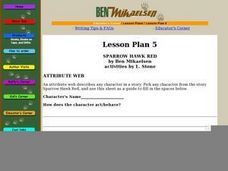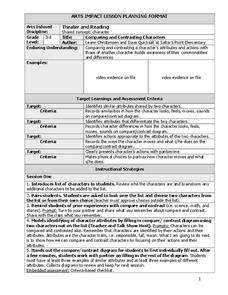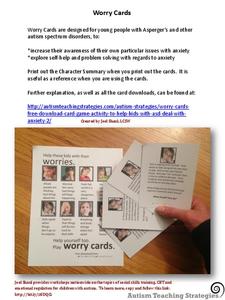Curated OER
Lesson 3: Looks, Actions, and Feelings
Remember that boy David from the David, No! books? He's back, and youngsters draw a picture of him from a scene in the book David Goes to School. They write a sentence describing his appearance, actions, and feelings as they discuss how...
Curated OER
Character Traits
Sixth graders explore details from a story to develop ideas and opinions about character traits. Using a Smart Board, 6th graders create a chart explaining the character's action and traits. In groups, students discuss and describe...
Curated OER
Sparrow Hawk Red - Attribute Web
A useful scaffold to help your class with character analysis and text interpretation. Questions about characters from Sparrow Hawk Red by Ben Mikaelsen guide your young readers to describe a character literally, along with interpreting...
Curated OER
Direct and Indirect Characterization
How does an author develop his or her characters? Using the short story "On the Bridge" by Todd Strasser, readers study character development by looking for examples of both direct and indirect characterization. They plot these points on...
Curated OER
Write Some Dialogue
Learners write dialogue. For this character development instructional activity students use direct or indirect speech to include a confrontation between two characters in their story. Learners portray the emotions of the characters in...
Curated OER
Lesson Plan 4: Creating Main Characters
Creating a good main character is a must when writing a creative narrative or novel. Elementary aged writers create main characters for the novel they are writing. They first use themselves as a models, then create a character as a...
La Jolla High School
Of Mice and Men by John Steinbeck: Sketching a Portrait--Characterization
John Steinbeck's Of Mice and Men is known for rich character development. Expose your class to indirect characterization and all that it involves with this activity. Learners look at quotes, determine what method of characterization is...
Curated OER
The Landlady Pre-Reading: The Characters
Prepare your class to read "The Landlady" by Roald Dahl with these pre-reading activities about the two main characters in the story. This resource provides a brief overview of the story as well as excerpts from the text that describe...
Curated OER
Taming of the Shrew, Act 4.3, Study Questions
Shakespeare can be a challenge to the most skilled high school readers. This selection of short answer questions helps increase understanding of the character, Katherine, by addressing dialogue, tone of voice, making inferences, and...
Humane Education Advocates Reaching Teachers
Justice for All - Educating Youth for Social Responsibility: Grades K-5
In grades kindergarten through fifth grade, scholars take part in a social-emotional learning unit designed to boost social responsibility. Three hundred pages provide lessons and activities related to everyday classroom practices, the...
Curated OER
Character Study
Third graders work in pairs to choose two characters and find their similarities and differences. For this character lesson, 3rd graders compare characters by their actions and attributes. Students individually complete a graphic...
my eCoach
Tuck Everlasting Chs. 1-8: Feelings About Living Forever
Approach big ideas and themes in Tuck Everlasting by Natalie Babbitt with this graphic organizer. Readers determine how each of the Tucks feels about living forever by looking for clues in the first eight chapters of the book. Consider...
Curated OER
What Can I Do?
Students investigate conflict resolution strategies. In this character education lesson, students list things that make them feel sad and are introduced to the conflict resolution strategy "think and share." Students role-play various...
Curated OER
Acting as a Pre-write Tool
Second graders use acting to help them in a prewriting activity to develop a story. In this prewriting lesson plan, 2nd graders form a character map and brainstorm ideas for their story.
Curated OER
Changes in Character
Third graders read the book Hi New Baby! and identify how the main character changes throughout the story. In this character lesson plan, 3rd graders write descriptive clues to explain the changes in feelings of the character.
Missouri Department of Elementary
Goldilocks Revisited
After a read-aloud of the story Goldielocks and the Three Bears, scholars gather into small groups to answer a series of questions. Peers examine the idea of smart decisions and identify three feelings of characters alongside three...
Novelinks
The Chosen: Biopoem
What better way to get to know a character than through a biopoem? Learners choose a character from Chaim Potok's The Chosen and create a well-crafted poem about his or her desires, traits, and ambitions.
International Boys' Schools Coalition
Empathy
Putting yourself in someone else's shoes is a common phrase we hear from time to time, but do children really understand? Explore empathy with elementary schoolers using these activities. Focusing on feelings and emotions, students role...
Novelinks
Tuck Everlasting: Bio-Poem
Learn about the characters of Natalie Babbitt's Tuck Everlasting with a character biopoem. Readers fill in a poem format to detail the character traits of Winnie, Jesse, Miles, and Mae, and share their finished poems with their peers.
K12 Reader
Abraham Lincoln Bio Poem
Everyone knows about Abraham Lincoln as a historical figure, but what was he like as a person? Young historians complete a biopoem about Lincoln, including his character traits, his relationships, his fears, and his needs.
Curated OER
Worry Cards
Help learners on the autism spectrum build awareness of their feelings of anxiety through a hands-on learning activity. Using a set of cards with examples of the different types of anxiety someone might face, learners discuss ideas of...
K20 LEARN
We've Got Character! Literary Analysis: Characterization
How authors bring characters to life and make them believable is the focus of a lesson on characterization. Readers closely examine passages from To Kill a Mockingbird and Dreamland Burning, noting details that reveal the character's...
EngageNY
Analyzing Character: Who is Lyddie?
Character analysis can help readers feel more connected to a literary text. Scholars explore the topic by writing an acrostic poem about the main character from Katherine Paterson's novel, Lyddie. Then, pupils watch a short video to help...
EngageNY
Close Reading to Learn about Lyddie’s Character
Scholars work in pairs to analyze the characters, plot, and setting of Katherine Paterson's novel, Lyddie. Next, they apply what they learned about the characters' feelings and motivation to perform a mini reader's theater.
Other popular searches
- Infer Character Feelings
- Character Feelings Chart
- Character Feelings in Books
- Inference Character Feelings
- Character Feelings Change
- Pantomine Character Feelings
- Panto Mine Character Feelings
- Character Feelings in Reading

























